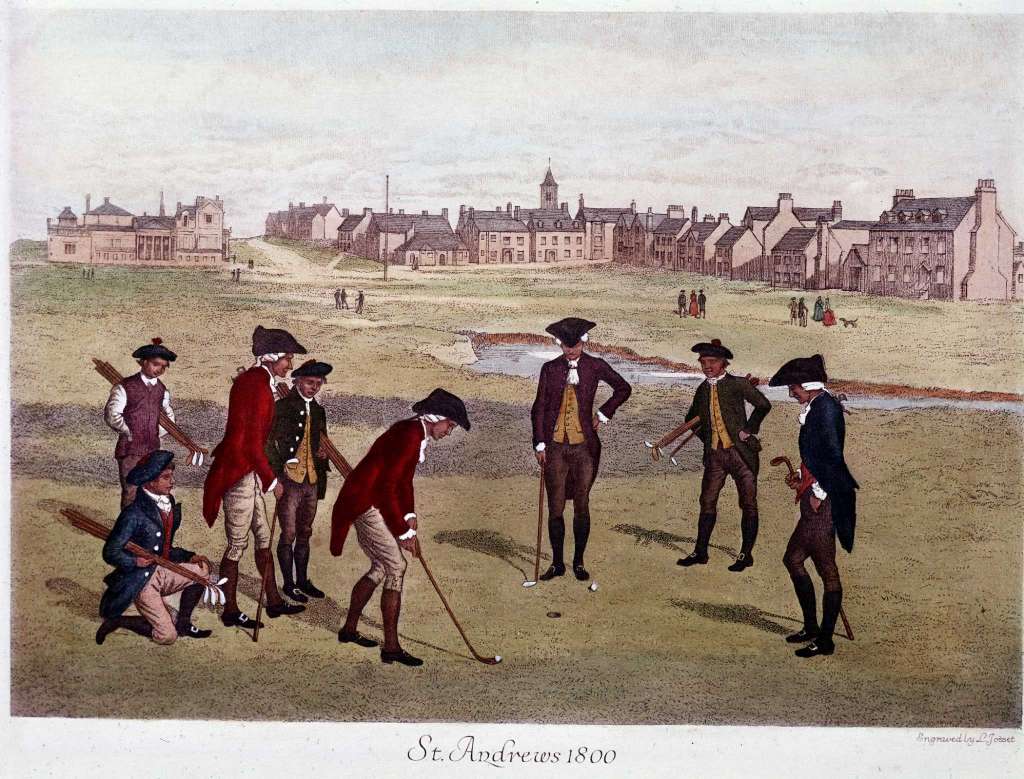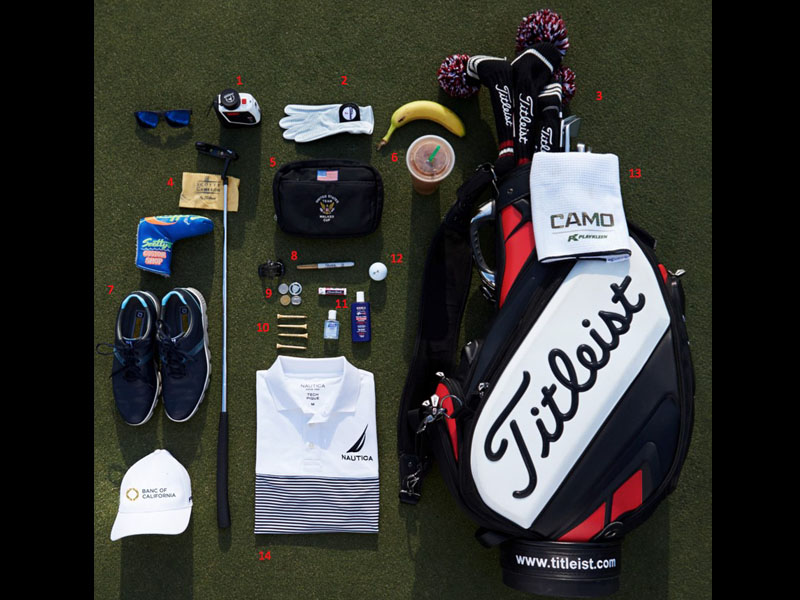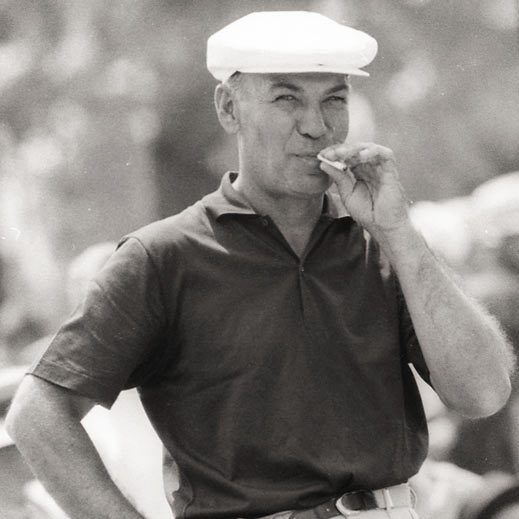Golf balls
Originally, golf balls were made of a hardwood, such as beech. Beginning between the 14th and 16th centuries, more expensive golf balls were made of a leather skin stuffed with down feathers; these were called “featheries”. Around the mid-1800s, a new material called gutta-percha, made from the latex of the East Asian sapodilla tree, started to be used to create more inexpensive golf balls nicknamed “gutties”, which had similar flight characteristics as featheries. These then progressed to “brambles” in the later 1800s, using a raised dimple pattern and resembling bramble fruit, and then to “meshies” beginning in the early 1900s, where ball manufacturers started experimenting with latex rubber cores and wound mesh skins that created recessed patterns over the ball’s surface. Recessed circular dimples were patented in 1910, but didn’t become popular until the 1940s after the patents expired.
The minimum allowed diameter of a golf ball is 42.67 mm and its mass may not exceed 45.93 g. Modern golf balls have a two-, three-, or four-layer design constructed from various synthetic materials. The surface usually has a pattern of 300-450 dimples designed to improve the ball’s aerodynamics by reducing the ball’s drag-inducing wake and allowing spin on the ball to create lift. The method of construction and materials used greatly affect the ball’s playing characteristics such as distance, trajectory, spin and feel. Harder materials, such as Surlyn, usually result in the ball’s traveling longer distances, while softer covers, such as urethane, tend to generate higher spin, more “feel” and greater stopping potential. Golf balls are separated into three groups depending on their construction: two-, three-, or four-piece covers. Generally four-piece golf balls tend to be the most expensive, though price is no assurance of quality.
Golf clubs
A player usually carries several clubs during the game (but no more than fourteen, the limit defined by the rules). There are three major types of clubs, known as woods, irons, and putters. Woods are played for long shots from the tee or fairway, and occasionally rough, while irons are for precision shots from fairways as well as from the rough. Wedges are irons used to play shorter shots. A new type of club called a hybrid combines the straight-hitting characteristics of irons with the easy-to-hit characteristics of higher-lofted woods. A hybrid is often used for long shots from difficult rough. Hybrids are also used by players who have a difficult time getting the ball airborne with long irons. Wedges are played from difficult ground such as sand or the rough and for approach shots to the green. Putters are mostly played on the green, but can also be useful when playing from bunkers or for some approach shots. Putters have minimal loft, forcing the ball to stay on the putting surface when struck. The most common clubs to find in a golfer’s bag are the driver, 3-wood, numbered irons from 3 to 9 (with hybrids commonly replacing the 3 and 4 iron), pitching and sand wedges, and a putter. Players commonly also carry a 5-wood, and/or additional wedges such as a gap or lob wedge.
Ball markers
When on the green, the ball may be picked up to be cleaned or if it is in the way of an opponent’s putting line; there are certain other circumstances in which a ball may be lifted. In these cases, the ball’s position must first be marked using a ball marker; this is typically a round, flat piece of metal or plastic that is differentiable from others in use. Ball markers are often integrated into other accessories, such as divot tools, scorekeeping tools or tee holders, and in the absence of a purpose-made marker, a small coin such as a penny is acceptable.
Tees
A tee is an object (wooden or plastic) that is pushed into or placed on the ground to rest a ball on top of for an easier shot; however, this is only allowed for the first stroke (tee shot or drive) of each hole. Conventional golf tees are basically spikes with a small cup on the head to hold the ball, and are usually made of wood or plastic. Wooden tees are generally very inexpensive and quite disposable; a player may damage or break many of these during the course of a round. Plastic tees are generally more expensive but last longer. The length of tees varies according to the club intended to be used and by personal preference; longer tees (3-3.5″) allow the player to position the ball higher off the ground while remaining stable when planted, and are generally used for modern deep-faced woods. They can be planted deeper for use with other clubs but then tend to break more often. Shorter tees (1.5-2.5″) are suitable for irons and are more easily inserted and less easily broken than long tees. Other designs of tee exist; the “step tee” is milled or molded with a spool-shaped upper half, and so generally provides a consistent ball height from shot to shot. The “brush tee” uses a collection of stiff bristles instead of a cup to position the ball; the design is touted by its manufacturer as providing less interference to the ball or club at impact, for a straighter, longer flight.
Alternately, the rules allow for a mound of sand to be used for the same function, also only on the first shot. Before the invention of the wooden spike tee, this was the only accepted method of lifting the ball for the initial shot. This is rarely done in modern times, as a tee is easier to place, hit from, and recover, but some courses prohibit the use of tees either for traditional reasons, or because a swing that hits the tee will drive it into or rip it out of the ground, resulting in damage to the turf of the tee-box. Tees also create litter if discarded incorrectly when broken.
Golf bag
A golfer typically transports golf clubs in a golf bag. Modern golf bags are made of nylon, canvas and/or leather, with plastic or metal reinforcement and framing, but historically bags have been made from other materials. Golf bags have several pockets designed for carrying various equipment and supplies required over the course of a round of golf. Virtually all bags are sectioned off with rigid supports at the top opening, both for rigidity and to separate clubs of various types for easier selection. More expensive bags have sleeves or pockets within the main compartment for each individual club, allowing for the desired club to be more easily removed from the bag and then returned without interference from the grips of the other clubs or internal hardware of the bag.
- Carry bagsare generally designed to be carried by the player while on the course; they have single or dual shoulder straps, and are generally of lightweight construction to reduce the burden on the player or caddy.
- Sunday bagsare commonly advertised as “minimalist” carry bags; they have very light weight and flexible construction allowing the bag to be rolled up or folded for storage without clubs, and have storage pockets for the essentials of play (clubs, balls, tees) but often lack more advanced features like segregated club storage, insulated pockets for drinks, stand legs etc.
- Stand bagsare in the family of carry bags but additionally feature rigid internal reinforcement and retractable fold-out legs, which make the bag a tripod allowing it to be securely placed on the turf. Modern carry bags are very commonly stand bags even at low pricepoints.
- Cart bagsare generally designed to be harnessed to a two-wheeled pull cart or a motorized golf cart during play of a round. They often have only a rudimentary carry strap or handle for loading and transporting the bag, and no stand legs, but may feature extra storage or more durable construction, as weight of the loaded bag is a lesser concern.
- Staff bagsare the largest class of golf bags, and are generally seen carried by caddies or other assistants to professional or high-level amateur players. Staff bags are generally the same size or larger than a cart bag, and typically feature a single shoulder strap, a large amount of storage for equipment and even spare attire, and large logo branding designed for product placement on televised events.
- Travel bagsare available with many combinations of size and features, but are distinguished by rigid and/or heavily padded construction, including the clubhead cover (which on most other bags is simply an unpadded “rain fly”), and locks on the zippers and bag cover. These features protect the clubs from abuse and theft, and generally makes the bag suitable for checked airline luggage. Travel bags are generally used by amateur players that travel occasionally, such as business executives; rigid flight cases that enclose the actual golf bag are generally preferred by touring players, as these cases can enclose any golf bag, are more discreet as to their contents thus further deterring theft, and the case’s weight and bulk can be left behind while on the course where it’s not needed.
Golf cart
Golf carts are vehicles used to transport golf bags and golfers along the golf course during a round of golf. Hand carts are designed to hold only the bag, and are used by players while walking along the course to relieve them of the weight of the bag. Carts that carry both player and bag are more common on public golf courses; most of these are powered by a battery and electric motors, though gasoline-powered carts are sometimes used by course staff, and some courses and players are beginning to explore alternatives such as bicycle-drawn carts.
The traditional way to play was to walk, but the use of golf carts is very common due to a number of factors. Chief among them is the sheer length of the modern course, and the required “pace of play” instituted by many courses to prevent delays for other golfers and maintain a schedule of tee times. A typical par-72 course would “measure out” at between 6,000 and 7,000 total yards, which does not count the distance between the green of one hole and the tee of the next, nor the additional distance caused by errant shots. A player walking a 7,000-yard course might traverse up to 5 miles (8km). With a typical required pace of play of 4 hours, a player would spend 1.6 hours of that time simply walking to their next shot, leaving an average of only two minutes for all players to make each of the 72 shots for a par score (and most casual players do not score the course par). Economics is another reason why carts have become prevalent at many courses; the fee for renting a cart is less expensive than paying a caddie to carry the bags, and the private club gets the money for the cart rentals. A golf cart also enables physically handicapped people to play the game. Carts are also popular with golfers who are too lazy to walk the course.
The use of carts may be restricted by local rules. Courses may institute rules such as “90 degree paths”, where drivers must stay on the cart path until level with their ball, and then may turn onto the course. This typically reduces the effect that the furrows from the cart wheels will have on balls. Soft ground due to rain or recent maintenance work may require a “cart path only” driving rule to protect the turf, and a similar policy may apply in general to the areas around tee boxes and greens (and on shorter par-3 holes where fairway shots are not expected). The use of carts is banned altogether at most major PGA tournaments; players walk the course assisted by a caddy who carries equipment.
Towels
Most golf bags have a ring to which a player can tie or clip a golf towel, used to wipe hands and clean or dry balls and club faces. Some of these towels can be quite specialized, with a carabiner or other clip to attach it to the bag with a grommet used on the towel for durability, and incorporating rougher materials in certain sections of the towel for club and ball cleaning with softer weaves elsewhere for drying. Other cleaning products abound, from motorized ball cleaners to an array of brushes for various types of clubs as well as balls and shoes.
Club head covers
Club head covers in use (head covers for Driver, Fairway Wood, Hybrid, Iron and Putter
Club head covers protect the clubs from striking each other and from weather and incidental damage while in the bag, make clubs more identifiable at a glance, and provide a personal touch to a player’s clubs. The most common club head covers are for a player’s driver and fairway woods, as modern designs have large hollow heads and long shafts that make them prone to damage, but covers for hybrids, putters, and even irons/wedges are also marketed.
Ball mark repair tool
A ball mark repair tool (also known as a pitchfork or divot tool) is used to repair a ball mark (a depression in the green where a ball has hit the ground on its approach shot). Some tees contain such a tool at the end, for pure convenience when on the green. To repair a ball mark, one pushes the tool next to the mark and pushes gently inwards from all sides, loosening the compacted turf to allow rapid regrowth of grass, and then flattens the mark with the smooth flat bottom of the putter to smooth the putting surface.










